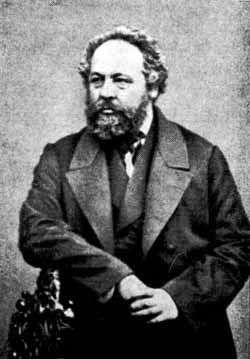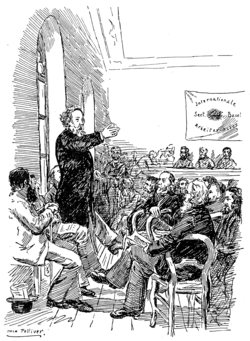Collectivist anarchism
Collectivist anarchism,[1] also referred to as anarchist collectivism[2] and anarcho-collectivism,[3] is a revolutionary socialist[4][5][6] doctrine and anarchist school of thought that advocates the abolition of both the state and private ownership of the means of production as it envisions in its place the means of production being owned collectively whilst controlled and self-managed by the producers and workers themselves. Notwithstanding the name, collectivism anarchism is seen as a blend of individualism and collectivism.[7]
For the collectivization of the means of production, collectivist anarchism originally envisaged that workers will revolt and forcibly collectivize the means of production.[6] Once collectivization takes place, money would be abolished to be replaced with labour notes and workers' salaries would be determined in democratic organizations of voluntary membership based on job difficulty and the amount of time they contributed to production. These salaries would be used to purchase goods in a communal market.[8]
Collectivist anarchism is contrasted with anarcho-communism, where wages would be abolished and where individuals would take freely from a storehouse of goods "to each according to his need". It is most commonly associated with Mikhail Bakunin, the anti-authoritarian sections of the International Workingmen's Association and the early Spanish anarchist movement.[9][10][11][12][13]
Collectivist anarchism was the dominant tendency of anarchism in the 19th century until anarcho-communism took its place.[14] As part of the social anarchist tradition, collectivist anarchism believes that "human beings are human animals, better suited to working together for the common good than striving for individual self-interest", supporting mutual aid.[15][16] While individualist anarchists advocate free-market anarchism and support mutualist property rights, seeing state interventions as distorting free competition, collectivist anarchists see such interventions as "merely prop up" for a "system of class exploitation", giving capitalism "a human face".[16]
First International

Giuseppe Fanelli met Bakunin at Ischia in 1866.[17] In October 1868, Bakunin sponsored Fanelli to travel to Barcelona to share his libertarian visions and recruit revolutionists to the International.[18] Fanelli's trip and the meeting he organised during his travels provided the catalyst for the Spanish exiles, the largest workers' and peasants' movement in modern Spain and the largest anarchist movement in modern Europe.[19] Fanelli's tour took him first to Barcelona, where he met and stayed with Elie Recluse.[19] Recluse and Fanelli were at odds over Recluse's friendships with Spanish republicans and Fanelli soon left Barcelona for Madrid.[19] Fanelli stayed in Madrid until the end of January 1869, conducting meetings to introduce Spanish workers, including Anselmo Lorenzo, to the First National.[20] In February 1869, Fanelli left Madrid, journeying home via Barcelona.[17] He met with painter Josep Lluís Pellicer and his cousin Rafael Farga i Pellicer, along with others who were to play an important role establishing the International in Barcelona[17] as well as the Alliance section.
In 1870, Bakunin led a failed uprising in Lyon on the principles later exemplified by the Paris Commune, calling for a general uprising in response to the collapse of the French government during the Franco-Prussian War, seeking to transform an imperialist conflict into social revolution, or what Vladimir Lenin later termed revolutionary defeatism. In his Letters to A Frenchman on the Present Crisis, Bakunin also argued for a revolutionary alliance between the working class and the peasantry, advocated a system of militias with elected officers as part of a system of self-governing communes and workplaces and argued the time was ripe for revolutionary action, saying that "we must spread our principles, not with words but with deeds, for this is the most popular, the most potent, and the most irresistible form of propaganda.[21]
These ideas corresponded strikingly close with the program of the Paris Commune in 1871, much of which was developed by followers of Pierre-Joseph Proudhon as Marxists were almost entirely absent from the Commune. Bakunin was a strong supporter of the Paris Commune, which was brutally suppressed by the French government. He saw the Paris Commune as above all a "rebellion against the State" and commended the Communards for rejecting not only the state, but also revolutionary dictatorship.[22] In a series of powerful pamphlets, he defended the Paris Commune and the International against the Italian nationalist Giuseppe Mazzini, thereby winning over many Italian republicans to the International and the cause of revolutionary socialism. The collectivist anarchists at first used the term collectivism to distinguish themselves from the mutualism of the followers of Proudhon and the state socialists associated with Karl Marx. In his 1867 essay "Federalism, Socialism, and Anti-Theologism", Bakunin wrote that "we shall always protest against anything that may in any way resemble communism or state socialism" which Bakunin regarded as fundamentally authoritarian.[23]

Bakunin's disagreements with Marx which led to the attempt by the Marx party to expel him at the Hague Congress in 1872 illustrated the growing divergence between the anti-authoritarian sections of the International, which advocated the direct revolutionary action and organization of the workers and peasants in order to abolish the state and capitalism; and the sections allied with Marx, which advocated the conquest of political power by the working class. Bakunin was "Marx's flamboyant chief opponent" and "presciently warned against the emergence of a communist authoritarianism that would take power over working people".[24]
The anti-authoritarian majority, which included most sections of the International, created their own International at the 1872 St. Imier Congress, adopted a revolutionary anarchist program and repudiated the Hague resolutions, rescinding Bakunin's alleged expulsion.[25] Although Bakunin accepted elements of Marx's class analysis and theories regarding capitalism, acknowledging "Marx's genius", he thought Marx's analysis was one-sided and that Marx's methods would compromise the social revolution. More importantly, Bakunin criticized authoritarian socialism which he associated with Marxism and the concept of dictatorship of the proletariat which he adamantly refused. Indeed, Bakunin's maxim was that "[i]f you took the most ardent revolutionary, vested him in absolute power, within a year he would be worse than the Tsar himself.[26]
The anti-authoritarian sections of the International proclaimed at the St. Imier Congress (1872) that "the aspirations of the proletariat can have no purpose other than the establishment of an absolutely free economic organization and federation, founded upon the labour and equality of all and absolutely independent of all political government" in which each worker will have the "right to the enjoyment of the gross product of his labours and thereby the means of developing his full intellectual, material and moral powers in a collective setting". This revolutionary transformation could "only be the outcome of the spontaneous action of the proletariat itself, its trades bodies and the autonomous communes".[27] A similar position was adopted by the Workers' Federation of the Spanish Region in 1882 as articulated by an anarchist veteran of the International Jose Llunas Pujols in his essay "Collectivism".[27]
By the early 1880s, most of the European anarchist movement had adopted an anarcho-communist position, advocating the abolition of wage labour and distribution according to need. Ironically, the collectivist label then became more commonly associated with nominally state socialists such as Marxists–Leninists who advocated the retention of some sort of wage system during the transition to full communism. The anarcho-communist Peter Kropotkin attacked this position in his essay "The Collectivist Wages System" which was reprinted in his book The Conquest of Bread in 1892.[28]
Theory
Bakunin's libertarian socialism was known as collectivist anarchism, where "socially: it seeks the confirmation of political equality by economic equality. This is not the removal of natural individual differences, but equality in the social rights of every individual from birth; in particular, equal means of subsistence, support, education and opportunity for every child, boy or girl, until maturity and equal resources, and facilities in adulthood to create his own well-being by his own labor".[29]
Collectivist anarchism advocates the abolition of both the state and private ownership of the means of production. It instead envisions the means of production being owned collectively and controlled and managed by the producers themselves. For the collectivization of the means of production, it was originally envisaged that workers will revolt and forcibly collectivize the means of production.[6] Once collectivization takes place, money would be abolished to be replaced with labour notes and workers' salaries would be determined in democratic organizations based on job difficulty and the amount of time they contributed to production. These salaries would be used to purchase goods in a communal market.[8]
Critique of Marxism

The dispute between Bakunin and Marx highlighted the differences between anarchism and Marxism. Bakunin argued—against certain ideas of a number of Marxists—that not all revolutions need to be violent. He also strongly rejected Marx's concept of the dictatorship of the proletariat, a concept that vanguardist socialism such as Marxist–Leninism would use to justify one-party rule from above by a party representing the proletariat.[30]
For instance, Bakunin stated the following in Statism and Anarchy about this Marxist concept:
[The Marxists] maintain that only a dictatorship—their dictatorship, of course—can create the will of the people, while our answer to this is: No dictatorship can have any other aim but that of self-perpetuation, and it can beget only slavery in the people tolerating it; freedom can be created only by freedom, that is, by a universal rebellion on the part of the people and free organization of the toiling masses from the bottom up".[31]
Bakunin insisted that revolutions must be led by the people directly while any "enlightened elite" must only exert influence by remaining "invisible [...] not imposed on anyone [...] [and] deprived of all official rights and significance".[32] He held that the state should be immediately abolished because all forms of government eventually lead to oppression.[30] While both anarchists and Marxists share the same final goal, the creation of a free, egalitarian society without social classes and government, they strongly disagree on how to achieve this goal. Anarchists, especially social anarchists, believe that the classless, stateless society should be established by the direct action of the masses, culminating in social revolution and refusing any intermediate stage such as the dictatorship of the proletariat on the basis that such a dictatorship will become a self-perpetuating fundament. However, libertarian Marxists argue that Marx used the phrase to mean that the worker control at the point of production and not a party would still be a state until society is reorganized according to socialist principles. For Bakunin, the fundamental contradiction is that for the Marxists "anarchism or freedom is the aim, while the state and dictatorship is the means, and so, in order to free the masses, they have first to be enslaved".[33] Bakunin also wrote of meeting Marx in 1844 as such:
As far as learning was concerned, Marx was, and still is, incomparably more advanced than I. I knew nothing at that time of political economy, I had not yet rid myself of my metaphysical observations. [...] He called me a sentimental idealist and he was right; I called him a vain man, perfidious and crafty, and I also was right.[34]
Bakunin found Marx's economic analysis very useful and began the job of translating Das Kapital into Russian. In turn, Marx wrote of the rebels in the Dresden insurrection of 1848 that "[i]n the Russian refugee Michael Bakunin they found a capable and cool headed leader".[35] Marx wrote to Friedrich Engels of meeting Bakunin in 1864 after his escape to Siberia, saying: "On the whole he is one of the few people whom I find not to have retrogressed after 16 years, but to have developed further".[36]
Bakunin has sometimes been called the first theorist of the "new class", meaning that a class of intellectuals and bureaucrats running the state in the name of the people or the proletariat—but in reality in their own interests alone. Bakunin argued that the "[s]tate has always been the patrimony of some privileged class: a priestly class, an aristocratic class, a bourgeois class. And finally, when all the other classes have exhausted themselves, the State then becomes the patrimony of the bureaucratic class and then falls—or, if you will, rises—to the position of a machine".[37]
Bakunin also had a different view as compared to Marx's on the revolutionary potential of the lumpenproletariat and the proletariat. As such, "[b]oth agreed that the proletariat would play a key role, but for Marx the proletariat was the exclusive, leading revolutionary agent while Bakunin entertained the possibility that the peasants and even the lumpenproletariat (the unemployed, common criminals, etc.) could rise to the occasion".[38] Bakunin "considers workers' integration in capital as destructive of more primary revolutionary forces. For Bakunin, the revolutionary archetype is found in a peasant milieu (which is presented as having longstanding insurrectionary traditions, as well as a communist archetype in its current social form—the peasant commune) and amongst educated unemployed youth, assorted marginals from all classes, brigands, robbers, the impoverished masses, and those on the margins of society who have escaped, been excluded from, or not yet subsumed in the discipline of emerging industrial work. [...] [I]n short, all those whom Marx sought to include in the category of the lumpenproletariat".[39]
Comparison with anarcho-communism
The difference between collectivist anarchism and anarcho-communism is that under the former a wage system is retained based on the amount of labor performed. Like collectivist anarchism, anarcho-communism also advocates for the socialization of production, but the distribution of goods as well. Instead of "to each according to his labor", in anarcho-communism the community would supply the subsistence requirements to each member free of charge according to the maxim "to each according to his needs".[40]
Collectivist anarchism stresses collective ownership of productive, subsistence and distributary property while anarcho-communism negates the concept of ownership in favor of usage or possession with productive means being a possession not owned by any individual or particular group. Anarcho-communists believe that subsistence, productive and distributive property should be common or social possessions while personal property should be private possessions. Collectivist anarchists agree with this, but disagree on the subject of remuneration as some collectivist anarchists such as Bakunin believe in the remuneration of labor while anarcho-communists such as Peter Kropotkin believe that such remuneration would lead to the recreation of currency and that this would need a state. Thus, it could be said that collectivist anarchists believe in freedom through collective ownership of production and a communal market of sorts to distribute goods and services and compensate workers in the form of remuneration. Collectivist anarchism could also be seen as a combination of communism and mutualism.
Collectivist anarchists are not necessarily opposed to the use of currency, but some while opposing the retaining of money—propose the adoption of labour vouchers or "personal credit" (such as participatory economists). Most collectivist anarchists see their philosophy as a carryover to anarcho-communist, but some see the system and the use of a labour voucher system as permanent rather than a transition. Collectivist anarchist James Guillaume argued that such a society would "guarantee the mutual use of the tools of production which are the property of each of these groups and which will by a reciprocal contract become the collective property of the whole [...] federation. In this way, the federation of groups will be able to [...] regulate the rate of production to meet the fluctuating needs of society".[41] They argue for workplace autonomy and self-management, saying that "the workers in the various factories have not the slightest intention of handing over their hard-won control of the tools of production to a superior power calling itself the 'corporation'".[42]
An Anarchist FAQ compares and contrasts collectivist anarchism with anarcho-communism this way:
The major difference between collectivists and communists is over the question of "money" after a revolution. Anarcho-communists consider the abolition of money to be essential, while anarcho-collectivists consider the end of private ownership of the means of production to be the key. As Kropotkin noted, "[collectivist anarchism] express[es] a state of things in which all necessaries for production are owned in common by the labour groups and the free communes, while the ways of retribution [i.e. distribution] of labour, communist or otherwise, would be settled by each group for itself."[43] Thus, while communism and collectivism both organise production in common via producers' associations, they differ in how the goods produced will be distributed. Communism is based on free consumption of all while collectivism is more likely to be based on the distribution of goods according to the labour contributed. However, most anarcho-collectivists think that, over time, as productivity increases and the sense of community becomes stronger, money will disappear.[44]
Performance
Application of many collectivist anarchists projects have been successful[45] as sources during the Spanish Revolution noted in the Catalan region:
In distribution the collectives' co-operatives eliminated middlemen, small merchants, wholesalers, and profiteers, thus greatly reducing consumer prices. The collectives eliminated most of the parasitic elements from rural life, and would have wiped them out altogether if they were not protected by corrupt officials and by the political parties. Non-collectivised areas benefited indirectly from the lower prices as well as from free services often rendered by the collectives (laundries, cinemas, schools, barber and beauty parlours, etc.)[46]
Tom Wetzel describes another collectivization:
Another industry that was totally re-organized was hair-cutting. Before July 19th, there had been 1,100 hairdressing parlors in Barcelona, most of them extremely marginal. The 5,000 assistant hairdressers were among the lowest-paid workers in Barcelona. The Generalitat had decreed a 40-hour week and 15 percent wage increase after July 19th—one of the Esquerra’s attempts to woo worker support. This spelled ruin for many hairdressing shops. A general assembly was held and it was agreed to shut down all the unprofitable shops. The 1,100 shops were replaced by a network of 235 neighborhood haircutting centers, with better equipment and lighting than the old shops. Due to the efficiencies gained, it was possible to raise wages by 40 percent. The entire network was run through assemblies of the CNT barber’s union. The former owners became members of the union.[45]
People
See also
References
- Avrich, Paul (1995) [2005]. Anarchist Voices: An Oral History of Anarchism in America. AK Press. p. 3. "All in all a wide range of views is represented: individualist anarchism, mutualist anarchism, collectivist anarchism, communist anarchism, and syndicalist anarchism, to mention only the most conspicuous." ISBN 978-1904859277.
- Kropotkin, Peter. (1905) [1987]. Anarchism and Anarchist Communism. Freedom Press. p. 19.
- Buckley, A. M. (2011). Anarchism. Essential Library. p. 97. "Collectivist anarchism, also called anarcho-collectivism, arose after mutualism." ISBN 978-1617147883.
- Rae, John (1901). Contemporary Socialism. C. Scribner's sons. p. 261.
- Morris, Brian (January 1993). Bakunin: The Philosophy of Freedom. Black Rose Books. p. 76. ISBN 978-1-895431-66-7.
- Patsouras, Louis (2005). Marx in Context. iUniverse. p. 54.
- Morris, Brian (1993). Bakukunin: The Philosophy of Freedom. Black Rose Books Ltd. p. 115.
- Bakunin, Mikhail [1980]. Bakunin on Anarchism. Black Rose Books. p. 369.
- Blonna, Alex (1977). Marxism and Anarchist Collectivism in the International Workingman's Association, 1864-1872. Blonna.
- Esenwein, George Richard (1989). Anarchist Ideology and the Working-class Movement in Spain, 1868-1898. University of California Press. p. 110. ISBN 978-0520063983.
- Martin, Benjamin (1990). The Agony of Modernization: Labor and Industrialization in Spain. Cornell University Press. p. 88. ISBN 978-0875461656.
- Ackelsberg, Martha A. (1991) [2005]. Free Women of Spain: Anarchism and the Struggle for the Emancipation of Women. AK Press. p. 61. ISBN 978-1902593968.
- Turcato, Davide. Making Sense of Anarchism: Errico Malatesta's Experiments with Revolution, 1889-1900. Palgrave Macmillan. ISBN 978-0230301795.
- McKay, Iain, ed. (2012). "G.2 Why do individualist anarchists reject social anarchism?". An Anarchist FAQ. II. Stirling: AK Press. ISBN 978-1-849351-22-5. OCLC 182529204.
No, far from it. Most anarchists in the late nineteenth century recognised communist-anarchism as a genuine form of anarchism and it quickly replaced collectivist anarchism as the dominant tendency. So few anarchists found the individualist solution to the social question or the attempts of some of them to excommunicate social anarchism from the movement convincin
- Maximoff, G. P. (1953). Political Philosophy of Bakunin. p. 167. "How ridiculous are the ideas of the individualists of the Jean Jacques Rousseau school and of the Proudhonian mutualists who conceive society as the result of the free contract of individuals absolutely independent of one another and entering into mutual relations only because of the convention drawn up among men. As if these men had dropped from the skies, bringing with them speech, will, original thought, and as if they were alien to anything of the earth, that is, anything having social origin".
- Heywood, Andrew (16 February 2017). "Anarchism". Political Ideologies: An Introduction (6th ed.). Macmillan International Higher Education. p. 146.
- Bookchin 1998, p. 14.
- Bookchin 1998, pp. 12–15.
- Bookchin 1998, p. 12.
- Bookchin 1998, p. 13.
- Bakunin, Mikhail (1870). "Letters to a Frenchman on the Present Crisis".
- Bakunin, Mikhail (1871). "The Paris Commune and the Idea of the State".
- Bakunin, Mikhail. "Federalism, Socialism, Anti-Theologism by Michael Bakunin". Marxists.org. Retrieved 1 April 2018.
- Verslius, Arthur (20 June 2005) "Death of the Left?" The American Conservative. Archived 20 October 2010 at the Wayback Machine. Retrieved 20 October 2010.
- Graham, Robert (March 2005). Anarchism: A Documentary History of Libertarian Ideas Volume One: From Anarchy to Anarchism (300CE to 1939). Black Rose Books.
- Quoted in Guérin, Daniel (1970). Anarchism: From Theory to Practice. New York: Monthly Review Press. pp. 25–26.
- Anarchism: A Documentary History of Libertarian Ideas, Volume One. Black Rose Books. Retrieved 12 July 2013.
- Kropotkin, Peter (1892). The Conquest of Bread. Penguin Classics. pp. 153–168.
- Bakunin, Mikhail (1866). Revolutionary Catechism.
- Woodcock, George (1962) [1975]. Anarchism. Harmondsworth, England: Penguin Books. p. 158. ISBN 0-14-020622-1.
- Anarchist Theory FAQ Version 5.2, Gmu.edu, retrieved 8 September 2009
- Was Bakunin a secret authoritarian?, Struggle.ws, retrieved 8 September 2009
- Bakunin, Mikhail, Works of Mikhail Bakunin 1873, Marxists.org, retrieved 8 September 2009
- Quoted in Morris, Brian (1993). Bakunin: The Philosophy of Freedom. p. 14.
- Marx, Karl (2 October 1852); Engels, Friedrich, ed. (1896). "Revolution and Counter-Revolution in Germany". New-York Daily Tribune.
- Quoted in Morris, Brian (1993). Bakunin: The Philosophy of Freedom. p. 29.
- "On the International Workingmen's Association and Karl Marx". Marxists Internet Archive. 1872. Retrieved 19 January 2020.
- Robertson, Ann. "Marxism and Anarchism: The Philosophical Roots of the Marx-Bakunin Conflict – Part Two" (PDF). Workerscompass.org. Retrieved 1 April 2018.
- Thoburn, Nicholas (2002). "The lumpenproletariat and the proletarian unnameable". In Deleuze, Marx and Politics (2003). "Difference in Marx: the lumpenproletariat and the proletarian unnamable".
- This paragraph sourced by Shatz, Marshall; Skinner, Quentin; Guess, Raymond (1995). The Conquest of Bread and Other Writings. Cambridge University Press. p. xvi.
- Guillaume, James (1972). Bakunin on Anarchism. p. 376.
- Guillaume, James (1972). Bakunin on Anarchism. p. 364.
- Anarchism. p. 295.
- "A.3 What types of anarchism are there?". An Anarchist FAQ. Archived from the original on 17 November 2001. Retrieved 25 October 2009.
- Wetzel, Tom. "Workers Power and the Spanish Revolution".
- Dolgoff, Sam, ed. (1974). The Anarchist Collectives. Free Life Editions. p. 114.
Further reading
- Bookchin, Murray (1998). The Spanish Anarchists: The Heroic Years, 1868–1936. Toronto: AK Press. ISBN 1-873176-04-X.
External links
- "The Collectivist Wages System" entry at the Anarchy Archives. Anarcho-communist Peter Kropotkin's criticism of collectivist anarchism from The Conquest of Bread (1892).

